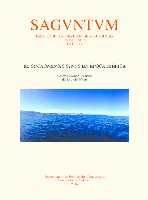
SAGVNTVM-Papeles del Laboratorio de Arqueologia de Valencia
Scope & Guideline
Pioneering Insights into the Archaeological Landscape of Valencia.
Introduction
Aims and Scopes
- Iberian Archaeology:
The journal showcases research focused on the archaeology of the Iberian Peninsula, including studies on ancient civilizations, cultural practices, and material culture. - Interdisciplinary Approaches:
Utilizing diverse methodologies, such as cognitive archaeology, neurobiology, and materials analysis, the journal promotes an interdisciplinary perspective in archaeological research. - Cultural Heritage and Identity:
The exploration of cultural heritage through archaeological findings, emphasizing how ancient societies shaped contemporary identities and understandings of the past. - Material Culture Studies:
In-depth analyses of artifacts, including pottery, inscriptions, and structural remains, to understand social practices, trade, and technological advancements. - Funerary Practices:
Research on burial sites and funerary customs, providing insights into the beliefs, social hierarchies, and rituals of past societies. - Historical Contextualization:
The journal emphasizes contextualizing archaeological findings within their historical frameworks to better understand the dynamics of ancient societies.
Trending and Emerging
- Cognitive Archaeology:
The integration of cognitive archaeology, focusing on the neurobiological aspects of human behavior and cognition in ancient societies, has gained traction, emphasizing how mental processes influenced cultural practices. - Material Analysis and Characterization:
There is an increasing focus on the material characterization of artifacts, using scientific techniques to understand production methods and trade networks, which enhances the understanding of ancient economies. - Anthropological Studies:
Research incorporating anthropological perspectives to analyze social structures, cultural practices, and daily life in ancient societies has become more prominent, providing a holistic view of historical communities. - Environmental Archaeology:
Emerging studies examining the interaction between ancient societies and their environments, including climate effects and resource management, reflect a growing interest in sustainability and ecological contexts. - Public Archaeology and Heritage Management:
There is a trend towards exploring the implications of archaeological research for contemporary heritage management and public engagement, indicating a commitment to making archaeology relevant to modern society.
Declining or Waning
- Prehistoric Archaeology:
There has been a noticeable decrease in publications focused specifically on prehistoric archaeology, indicating a shift towards more historical periods and contexts. - Classical Antiquity Studies:
Research centered on classical antiquity, particularly Greek and Roman studies, seems to be less frequent, possibly overshadowed by more localized studies of Iberian cultures. - Generalized Art Historical Analysis:
The trend of broad art historical analyses that do not connect directly with archaeological findings has diminished, suggesting a preference for more integrated studies that combine art with archaeological context. - Thematic Monographs:
Fewer thematic monographs exploring singular topics in depth have been published, indicating a potential shift towards more diverse and varied research outputs. - Regional Studies Outside Iberia:
There is a waning interest in archaeological studies related to regions outside of the Iberian Peninsula, as the journal increasingly focuses on localized research.
Similar Journals
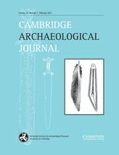
CAMBRIDGE ARCHAEOLOGICAL JOURNAL
Illuminating the Past, Inspiring the FutureThe Cambridge Archaeological Journal, published by Cambridge University Press, is a premier academic journal dedicated to archaeology and cultural studies. With an ISSN of 0959-7743 and an E-ISSN of 1474-0540, it has established itself as a leading platform since its inception in 1991, showcasing groundbreaking research that significantly contributes to our understanding of human history and cultural heritage. The journal currently ranks in the top quartile (Q1) across various categories, including Archaeology and Cultural Studies, underlining its impact and relevance in the field. The impact factor reflects its esteemed position, with Scopus ranks placing it within the 90th to 93rd percentiles among its peers. Researchers, professionals, and students alike benefit from its insightful analyses and interdisciplinary approaches, making it an essential resource for advancing knowledge in archaeology and related fields. The journal is based in the United Kingdom, at the Edinburgh Building, Shaftesbury Rd, CB2 8RU, Cambridge, England, and continues to drive scholarly conversations through its commitment to excellence and innovation in archaeological studies.

Ancient Asia-Journal of the Society of South Asian Archaeology
Exploring the Depths of Ancient CivilizationsAncient Asia - Journal of the Society of South Asian Archaeology, published by ARF India, stands as a pivotal resource for the exploration and dissemination of archaeological research focused on the rich history and culture of South Asia. Since its inception as an Open Access journal in 2006, it has become an essential platform for scholars and enthusiasts alike, boasting an impressive range of quartile rankings across multiple disciplines, including Anthropology, Archaeology, History, and Visual Arts. With expansion into various indexed categories and consistent dissemination of impactful research common to this highly diverse field, Ancient Asia aims to foster interdisciplinary dialogue, facilitate collaboration among researchers, and enhance the global understanding of ancient civilizations within the region. By embracing an inclusive access model, the journal encourages wide readership and engagement, positioning itself as a key player for students, professionals, and academics interested in delving into the archaeological marvels of South Asia.

Prilozi Instituta za Arheologiju u Zagrebu
Fostering scholarly dialogue on the cultural heritage of the region.Prilozi Instituta za Arheologiju u Zagrebu is a prominent academic journal published by INST ARHEOLOGIJU, dedicated to advancing the field of archaeology and related historical studies. Operating in Croatia, this journal serves as a vital platform for scholars, researchers, and students to disseminate innovative research and insights within the realm of archaeology, with a focus on the rich cultural heritage of the region. The journal spans contributions from 2002 to 2011 and has ongoing publication since 2013, reflecting its commitment to contemporary archaeological discourse. With a growing reputation, it has achieved a Q3 ranking in the fields of Archaeology and Arts and Humanities, and a Q2 ranking in History, signifying its impact and relevance in the academic community. Although Open Access options are not available, the journal remains an essential resource for those pursuing in-depth knowledge and research in archaeology. Researchers can harness the journal's extensive scope to explore critical historical narratives and archaeological findings, solidifying its importance in both local and global contexts.
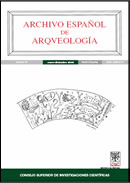
Archivo Espanol de Arqueologia
Advancing archaeological knowledge through open access.Archivo Español de Arqueología is a prestigious journal published by the Consejo Superior de Investigaciones Científicas (CSIC), dedicated to the field of archaeology and the historical sciences. Since its transition to Open Access in 1991, this journal has been a significant resource for scholars and practitioners in Spain and beyond, ensuring the dissemination of high-quality research to a broad audience. With an impressive Scopus ranking that places it within the top 20% of journals in the disciplines of History and Archaeology, Archivo Español de Arqueología plays a crucial role in advancing academic discourse and promoting innovative archaeological methodologies. The journal has maintained rigorous standards, reflected in its placement within the Q2 and Q3 quartiles, enabling it to establish a reputation for excellence and reliability in archaeological scholarship. Researchers, professionals, and students are encouraged to explore the journal's diverse array of articles from its foundation year of 2009 to the present, enriching their understanding of the past through the latest findings and theoretical advancements in archaeology.
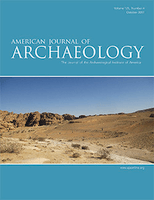
AMERICAN JOURNAL OF ARCHAEOLOGY
Transforming Excavations into Global KnowledgeThe American Journal of Archaeology (ISSN: 0002-9114, E-ISSN: 1939-828X), published by the esteemed University of Chicago Press, stands as a leading scholarly journal in the field of archaeology, celebrated for its rigorous peer-reviewed research. With an impressive impact factor that places it in the Q1 quartile for both archaeology and archaeology within the arts and humanities, this journal ranks among the top 15% in its field, according to Scopus metrics. It serves a global audience of researchers, professionals, and students, facilitating the dissemination of innovative findings from excavations, historical analyses, and methodological advancements. While primarily available through subscription, the journal's archives and features provide invaluable resources for deepening one's understanding of the past and engaging with current archaeological discourse. Operating from its home in Chicago, USA, the American Journal of Archaeology actively contributes to the advancement of knowledge and scholarship in archaeology, making it an essential platform for those invested in the exploration of ancient civilizations and cultural heritage.
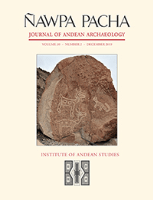
Nawpa Pacha
Innovating Methodologies for Modern Archaeological Challenges.Nawpa Pacha, a prestigious journal published by Taylor & Francis Ltd, stands as a significant platform for advancing research in Archaeology within the fields of Arts and Humanities. Since its inception in 2019, it has rapidly established itself with an impressive impact, evidenced by its categorization in the Q1 quartile for Archaeology and its significant rankings—placing it at Rank #88 in the Arts and Humanities category and Rank #86 in the Social Sciences. Published in the United Kingdom, the journal aims to foster interdisciplinary dialogue and promote scholarly work that contributes to the understanding of archaeological heritage and practices. Researchers, professionals, and students alike will find this journal indispensable for disseminating innovative methodologies, theoretical frameworks, and case studies that push the boundaries of archaeological inquiry. Whether seeking to explore historical narratives or contemporary archaeological challenges, Nawpa Pacha serves as a vital resource in the ever-evolving landscape of archaeological research.
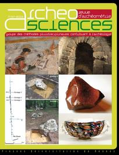
ArcheoSciences-Revue d Archeometrie
Empowering Researchers with Cutting-edge Archaeometric TechniquesArcheoSciences-Revue d Archeometrie is a prominent scholarly journal dedicated to the field of archaeology, published by PRESSES UNIV RENNES in France. With an ISSN of 1960-1360 and an E-ISSN of 2104-3728, this journal has gained recognition for its focus on the intersection of science and archaeological research, aiming to foster interdisciplinary dialogue and innovative methodologies within archaeological studies. Although coverage of the journal has been discontinued in Scopus post-2021, it has maintained a respectable standing with a Q3 Quartile ranking in both the Archaeology (Arts and Humanities) and Archaeology categories as of 2023, as well as commendable Scopus rankings in relevant fields. As an accessible platform for researchers, professionals, and students, ArcheoSciences offers valuable insights into applied techniques and findings in archaeological science, making it an essential resource for those involved in the historical and cultural analysis of material relics. Researchers are encouraged to explore this journal to stay informed about frontier research and ongoing discussions in the discipline.

OLBA
Reviving Interest in Archaeological NarrativesOLBA is a distinguished journal in the field of archaeology, published by Mersin University Publications Research Center Cilician Archaeology in Turkey. With an ISSN of 1301-7667, this academic journal has been a platform for scholarly discourse from 2009 to 2014 and again from 2016 to 2019, with a recent volume published in 2022. Although it is currently categorized in the fourth quartile (Q4) for both Arts and Humanities and Social Sciences within archaeology, OLBA continues to contribute significantly to the global archaeology community. It serves as an essential resource for researchers, professionals, and students interested in the diverse aspects of archaeological studies and cultural heritage. Despite not being an open-access journal, OLBA strives to disseminate knowledge effectively, aiding in the exploration of ancient civilizations and the rich tapestry of human history. Its Scopus rankings, placing it in the bottom percentiles, demonstrate the ongoing need for the community to support and engage with the journal to enhance its visibility and impact in the archaeological domain.

Cuadernos de Prehistoria y Arqueologia-Universidad Autonoma de Madrid
Elevating Scholarly Excellence in Prehistoric InquiryCuadernos de Prehistoria y Arqueologia-Universidad Autonoma de Madrid is a distinguished academic journal dedicated to the fields of archaeology and prehistory, published by the Universidad Autonoma de Madrid, Departamento de Prehistoria y Arqueología. With an ISSN of 0211-1608, this journal plays a crucial role in disseminating significant research findings and theoretical advancements within these domains. Recognized for its scholarly excellence, it holds impressive quartile rankings in 2023, including Q2 in Archaeology and Q1 in History, reflecting its high impact within the academic community. While currently not an open-access publication, Cuadernos de Prehistoria y Arqueologia provides valuable insights to researchers, professionals, and students engaged in the exploration of human history and cultural heritage from 2018 to 2024 and beyond. With a commitment to fostering interdisciplinary dialogue, this journal serves as an essential platform for innovative studies and comprehensive reviews, contributing to the advancement of knowledge in archaeology and prehistory.

Complutum
Pioneering Research in the Heart of History and ArcheologyComplutum, published by the Universidad Complutense de Madrid, serves as a leading academic journal in the fields of Archeology and History. With a notable track record since its inception and a convergence stretching from 2011 to 2024, the journal has established itself as a pivotal platform for scholarly discourse in these disciplines. Recognized in 2023 with a Q2 ranking in Archeology and Arts and Humanities, as well as a Q1 ranking in History, Complutum demonstrates its commitment to quality research, attracting contributions from leading experts and emerging scholars alike. The journal's impact is further evidenced by its competitive ranks within various Scopus categories, particularly its placement in the 77th percentile for History and 64th for Archeology. As a printed publication without open access options, Complutum caters to a specialized audience, providing a forum for in-depth analysis and discussion on archaeological findings and historical interpretations. Researchers, professionals, and students engaged in these fields will find Complutum an invaluable resource for advancing knowledge and fostering academic collaboration.